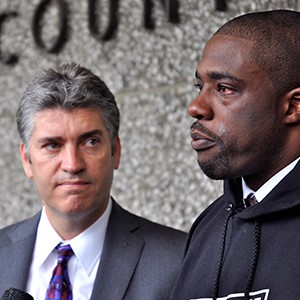
Attorney Justin Brooks and client Brian Banks, who was wrongfully convicted of rape at age 17.
“There are few things in life that are worse than being in prison for something you didn’t do,” says Justin Brooks, director of the California Innocence Project at California Western School of Law. In 1999, Brooks and Professor Jan Stiglitz co-founded the project — an in-house law school clinic that investigates and litigates cases of factual innocence while training law students to be advocates for justice. The project has been recognized with numerous awards, as well as international media attention for its success in exonerating the wrongfully convicted .
Brooks brought his vast knowledge of this fascinating and tragic topic to San Diego State University’s One-Unit Weekend program through the College of Extended Studies last year, and will be teaching it again on Feb. 3 & 11. One-Unit Weekend courses allow SDSU students to earn extra units for graduation while also learning about the latest developments on important current issues. Course topics are so intriguing that community members often take advantage of the fact that they’re open to the public.
Brooks — also the director of the Institute for Criminal Defense Advocacy, and California Western’s LL.M. in Trial Advocacy Specializing in Federal Criminal Law — gives us an overview.
How many Innocence Projects existed in the U.S. when you co-founded the California Innocence Project?
There were projects in New York, Wisconsin, Washington, Arizona, and Chicago.
Was there a specific catalyst for founding the California Innocence Project or just the natural progression of your career as a criminal defense attorney?
I had represented a 21-year-old woman on death row in Illinois. I was shocked to find out that she had been convicted and sentenced to death on a plea bargain in a case with compelling evidence of innocence. I investigated the case with law students and we were able to get her death sentence reversed. That case made me realize there were innocent people in prison who needed help and that the best way to train students to be great lawyers was to work with them on real cases. Thus, the birth of the California Innocence Project.
Who was the first-ever wrongfully convicted client you exonerated?
Jason Kindle. He was sentenced to life on a robbery based on a bad identification. We proved another person committed the crime by using a photo of the robber entering the store and calculating his height based on the door height. The actual robber was six inches taller than our client.
What were students of your Wrongful Convictions One-Unit Weekend course most shocked to learn?
I think it’s hard for anyone to realize how easy it is to be wrongfully convicted. I talked about cases where faulty eyewitness testimony, false testimony, false confessions, bad science, and bad lawyering put people behind bars for many years before we could exonerate them.
What percentage of incarcerated people are innocent?
There is no way to exactly know, but a recent federal study found that 4 percent of death row inmates had been found innocent after being sentenced to death. Death row cases receive the most media scrutiny, have a more thorough trial process, and get automatic review by the state supreme court. If 4 percent of death penalty cases lead to wrongful convictions, then the number is much higher for lesser crimes.
Are most people unaware of the amount of innocent people behind bars?
Twenty years ago I think that was true. Now, the media has saturated the news, movies, television, and books with these tragic stories. Still, I think some people refuse to believe it because if you believe there are wrongful convictions, then you must accept it could happen to you or a loved one.
Can you share an anecdote that you always share when teaching — either a long-fought victory or an outstanding injustice?
All of the cases I do involve incredible stories of injustice. I like to always tell students about the moment my client walks out of prison. That feeling is obviously overwhelming for them, but for me as well. There is no greater joy I have felt in my life than that moment — when someone gets their life back.
Incorrect ID by eyewitnesses was a factor in over 70 percent of wrongful convictions and the very reason the national Innocence Project was established back in 1992. Now that DNA evidence plays such a huge role, is eyewitness testimony dramatically less relevant?
Faulty identifications are still putting people in prison regardless of DNA. DNA typically only plays a role in rape and murder cases. Those are a small percentage of the criminal cases filed each year.
One of the goals of the CIP is to change laws and procedures to decrease the number of wrongful convictions and improve the justice system. Have you actually seen a decrease?
That’s hard to say exactly, but I believe that we have. We’ve been deeply involved in the reform movement including, for example, the reform of how eyewitness procedures are done. That decreases the number of wrongful convictions and increases the number of rightful ones.
Is there anything a person could do to decrease their chances of this nightmare happening to them?
The truth is that it’s not likely to happen to most people, and certainly if you’re poor and a person of color your chances of being wrongfully convicted increase. I would always advise people to get a good lawyer, but that doesn’t mean firing your public defender. I have seen the most wrongful convictions involving private lawyers who have no supervision, no training, and who don’t hire investigators. Public defenders might be overworked but they have supervisors, training, and access to investigators.
What’s your primary source of finding out about wrongful convictions — inmates writing directly to the CIP?
Yes. Most of our cases come directly from inmates writing to us. Families write us as well.
Do you look into every case until you find a disqualifying fact?
Yes.
How many of your annual cases go the distance — meaning the wrongfully convicted person is freed?
We review 1500-2000 cases a year but in most of them there is no chance we will develop the evidence needed to win their cases regardless of whether they are innocent. Our clients have lost their trials and their appeals and we are the last stop. At trial, the prosecution must prove guilt. We must prove innocence. So, only about 50 cases a year make it into serious investigation and we file habeas petitions in three to five cases. In a good year we walk one to two people out of prison. So, it’s 1000 to 1. The sad thing is that many more are innocent, we just have no way to prove it.
How long can that process take?
We review cases immediately and most cases are closed within months because we can’t do anything further. In terms of litigation of the cases we take on, that can take years. We have a few cases we have been fighting more than 15 years.
What were some of the comments you got from students at the end of the SDSU course?
Many of the students talked about how much they enjoyed the stories of how we won very tough cases. I think a few of them were surprised that the class attracted them to a career in criminal law.
Does the CIP’s work rely entirely on tax-deductible donations?
California Western School of Law gives us a great deal of support, but they cannot cover our case expenses. We really need donations to get these innocent people out of prison.
How else can the public help?
Donate to our cause at californiainnocenceproject.org.
Follow me on Twitter @justinobrooks and retweet the tweets I send every day to Governor Jerry Brown asking him to act on the clemency petitions of our clients. I personally walked 712 miles from San Diego to Sacramento, along with two of my young lawyers, to deliver those petitions to him three years ago and he has still taken no action.
Go to our website and educate yourself about the problem.
Volunteer at our project or another innocence organization.
Do you stay in touch with people you’ve freed?
Always. After years of working on these cases, the clients become family. I see almost all of them regularly.
What did you want to be when you grew up?
I found a paper I wrote when I was in 7th grade saying I wanted to be a lawyer, but a business lawyer. Nothing like what I do now.
Anything you’d like to add?
I always tell my students to find something they love, something they are truly passionate about, and work will never feel like work. I am lucky that my job is a mission.
Learn more about One-Unit Weekend courses at neverstoplearning.net/oneunit.




